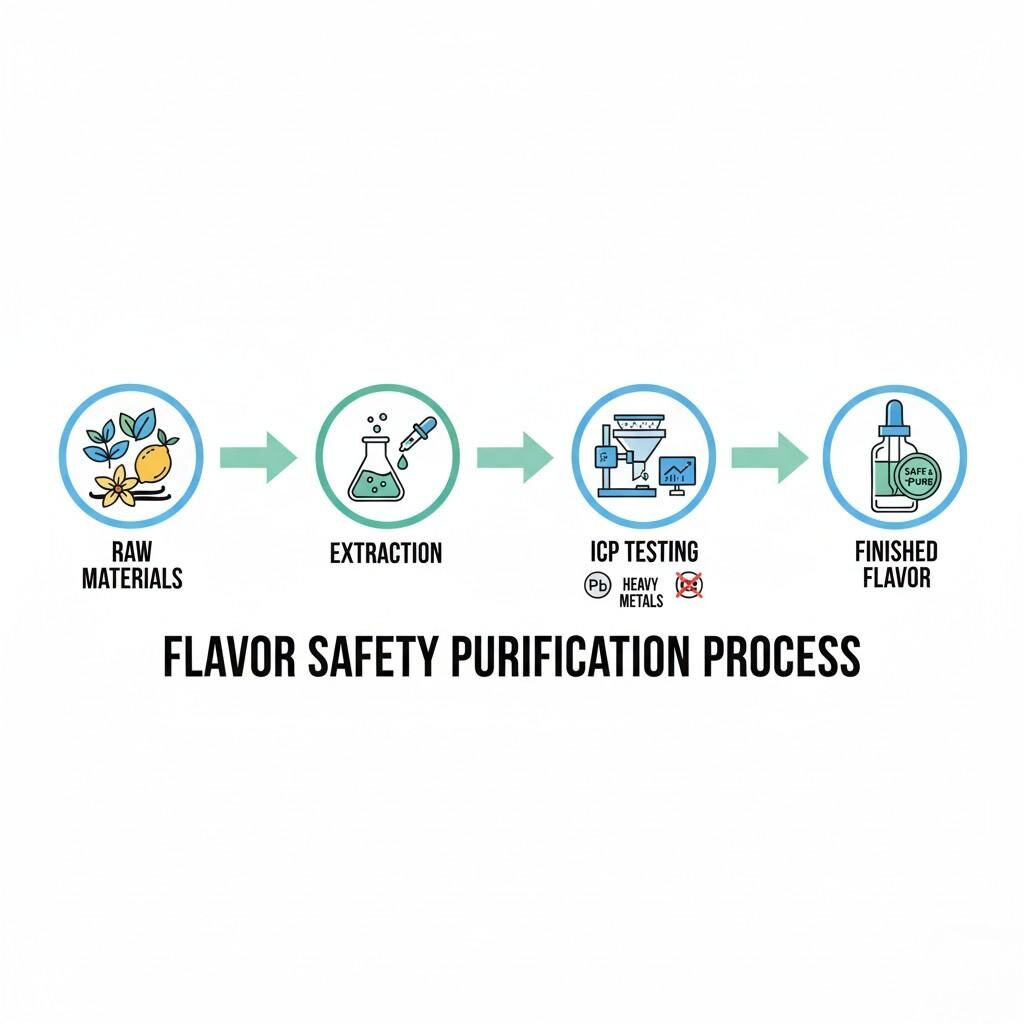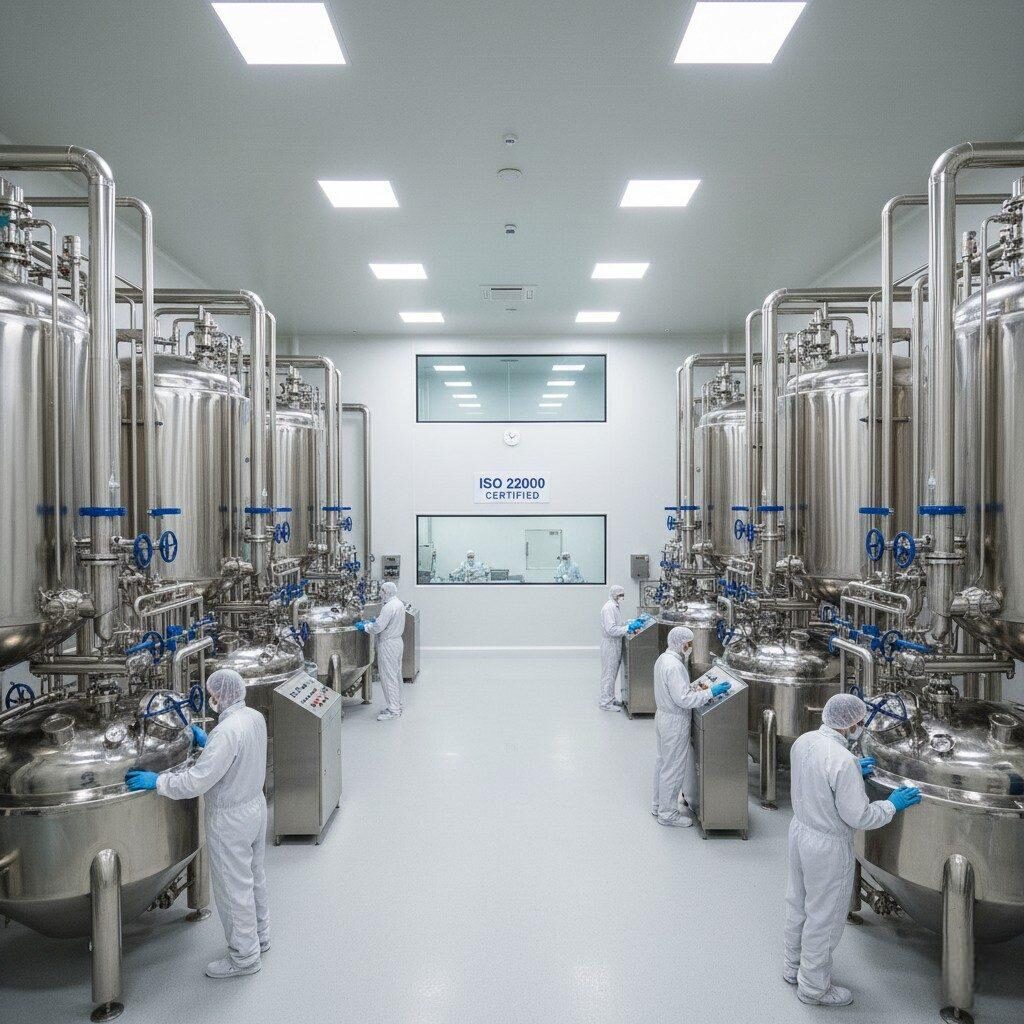Author: R&D Team, CUIGUAI Flavoring
Published by: Guangdong Unique Flavor Co., Ltd.
Last Updated: Nov 14, 2025

Essential Oil Heavy Metal Analysis
In the global food and beverage industry, flavorings are the foundation of sensory experience and brand identity. Yet behind every citrus essence, vanilla note, or herbal distillate lies a fundamental responsibility — safety and compliance. Among all potential contaminants in the supply chain, heavy metals are among the most serious.
Even trace concentrations of lead (Pb), arsenic (As), cadmium (Cd), and mercury (Hg) can undermine consumer trust, violate export regulations, and compromise product stability. These metals have no nutritional value and accumulate over time in the human body, posing toxicological risks that global food safety authorities vigilantly monitor.
The purpose of this article is to provide food and beverage manufacturers, flavor formulators, and procurement professionals with a comprehensive technical guide on identifying, managing, and preventing heavy metal contamination in food-grade flavor production. We will explore regulatory frameworks, testing methodologies, sourcing strategies, and the scientific principles underpinning purity and compliance.
Heavy metals are elements with high atomic weights and densities typically five times greater than water. While some (such as zinc, copper, and iron) are essential micronutrients, others—lead, cadmium, mercury, and arsenic—are purely toxic.
These metals can interfere with enzyme activity, displace vital minerals, and accumulate in organs such as the liver, kidneys, and brain. According to the World Health Organization (WHO), chronic exposure can result in irreversible neurological and cardiovascular damage, particularly in children and pregnant women (WHO, 2021).
The danger of heavy metals in flavor compounds lies in their invisibility—they do not alter taste, color, or odor at trace levels. As such, only analytical testing can confirm product purity.
Understanding contamination pathways is crucial for effective prevention. Heavy metals may enter the supply chain at multiple points, from the agricultural stage to the blending line.
Many flavor ingredients derive from plants, fruits, roots, and spices. When soil or irrigation water is contaminated with industrial waste or heavy-metal-rich fertilizers, crops absorb these elements through their root systems.
A 2020 report by the European Food Safety Authority (EFSA) confirmed that cadmium contamination is a widespread concern in cocoa, spices, and herbal raw materials used for flavor extraction (EFSA, 2020).
Once raw botanicals are harvested, contamination risks shift to the factory environment. Improper equipment, low-quality catalysts, or corroded stainless-steel vessels may release trace metals during distillation or solvent extraction. For example:
Storage containers can be overlooked sources of contamination. Metal drums, soldered joints, or non-food-grade coatings may release residues into stored flavor concentrates—especially when exposed to fluctuating temperature or humidity.
Compliance with FDA 21 CFR Part 175–178 and EU Regulation 1935/2004 ensures that food-contact packaging does not introduce harmful substances into flavor ingredients.
Food-grade flavorings are subject to strict contaminant limits set by national and international agencies. These standards define permissible levels of lead, arsenic, cadmium, and mercury across various food categories.
| Authority | Reference Regulation | Lead (Pb) | Cadmium (Cd) | Arsenic (As) | Mercury (Hg) |
| U.S. FDA | 21 CFR 170.30, 184.1155 | ≤ 0.5 mg/kg | ≤ 0.1 mg/kg | ≤ 0.1 mg/kg | ≤ 0.05 mg/kg |
| European Union (EFSA) | EC Regulation 1881/2006 | ≤ 0.3 mg/kg | ≤ 0.1 mg/kg | ≤ 0.1 mg/kg | ≤ 0.03 mg/kg |
| Codex Alimentarius (FAO/WHO) | CODEX STAN 193-1995 | ≤ 0.5 mg/kg | ≤ 0.1 mg/kg | ≤ 0.1 mg/kg | ≤ 0.05 mg/kg |
| China (GB Standards) | GB 2762-2022 | ≤ 0.5 mg/kg | ≤ 0.1 mg/kg | ≤ 0.2 mg/kg | ≤ 0.05 mg/kg |
These figures highlight a global consensus toward minimizing heavy metal exposure. Exporters must maintain documentation such as Certificates of Analysis (COA), safety data sheets (SDS), and third-party test reports to demonstrate compliance.
In the United States, the FDA’s Total Diet Study and Toxic Elements in Food and Foodware Program actively monitor heavy metal exposure in consumer goods (FDA, 2023).

Chemist Testing Essential Oils
Testing is the backbone of contamination control. The sensitivity and precision of analytical methods determine the accuracy of heavy metal risk assessment.
ICP-MS detects metal ions at parts-per-trillion (ppt) levels, making it ideal for verifying compliance with international limits. It’s used in advanced flavor laboratories for multi-element analysis.
ICP-OES provides rapid multi-element quantification, suitable for production-level testing where throughput is important.
GFAAS excels at quantifying ultra-trace lead and cadmium levels with high accuracy and lower sample volumes.
A portable and non-destructive method, XRF allows for on-site screening of packaging materials and raw botanical powders for metallic contaminants.
All tests should be conducted by ISO/IEC 17025-accredited laboratories, ensuring traceable results recognized by global authorities.
A comprehensive heavy metal control program involves preventive design, testing, and traceability.
Reliable suppliers are the foundation of safety. Implement a structured vendor qualification process including:
Integrate heavy metal monitoring into your HACCP plan under “chemical hazards.” Define Critical Control Points (CCPs) at:
Corrective actions (such as product hold or supplier requalification) should be pre-defined for any non-conforming batch.
All processing contact surfaces must be corrosion-resistant (316L stainless steel or PTFE). Routine passivation and inspection schedules reduce metal migration risk. Implement predictive maintenance to identify equipment wear early.
Retain representative samples from each flavor batch for at least one year beyond shelf life. These serve as reference materials in case of regulatory inquiries or quality complaints.
To meet the growing demand for ultra-pure and natural flavor concentrates, manufacturers employ several state-of-the-art purification methods:
Chelating agents (e.g., EDTA derivatives or plant-based ligands) selectively bind heavy metal ions, allowing them to be filtered out without altering sensory characteristics.
Highly porous carbon materials adsorb trace contaminants effectively, particularly for essential oils and solvent-extracted flavors.
Membrane systems remove ionic and molecular impurities while preserving volatile compounds responsible for aroma and taste.
Used in aqueous flavor solutions to capture specific heavy metal cations, this technique ensures chemical precision and reproducibility.
Each purification step should be validated under GMP (Good Manufacturing Practice) to prevent unintended flavor loss or instability.

Flavor Safety Infographic
Compliance is not just about testing; it’s about traceable documentation. Regulators and corporate buyers increasingly demand:
For exporters, this documentation simplifies customs clearance and ensures smooth acceptance in markets like the EU, USA, Japan, and the Middle East.
A European beverage manufacturer reported periodic lead exceedances in citrus oil flavor batches. After tracing the contamination source, the issue was found to originate from aging distillation equipment and contaminated raw peels.
By replacing bronze valves with 316L stainless steel components, retraining suppliers on agricultural water management, and instituting quarterly ICP-MS testing, the company achieved a 96% reduction in contamination incidents within one year.
This case demonstrates that both technical controls and supplier collaboration are vital to long-term safety success.
The integration of digital traceability systems, blockchain technology, and AI-based quality prediction models is transforming how flavor manufacturers ensure purity.
By recording every transaction from farm to factory, blockchain ensures transparency, enabling instant recall or verification when contamination alerts occur.
Machine learning algorithms can analyze soil data, supplier history, and meteorological patterns to predict contamination risks before sourcing decisions are made.
LIMS platforms manage analytical data, automate COA generation, and integrate results directly into ERP systems, streamlining compliance reporting.
These technologies collectively elevate consumer confidence and regulatory readiness.
Technology alone cannot guarantee safety; people are equally critical. Training programs for procurement, production, and QA personnel should emphasize:
A safety-oriented culture ensures that every employee views contamination prevention as part of their professional responsibility.
The future of the flavor industry points toward “zero contamination manufacturing”. Consumer demand for organic and clean-label products drives innovation in purification and monitoring.
Key future trends include:
Collaborative international initiatives like the Codex Committee on Contaminants in Foods (CCCF) are also harmonizing limits and methodologies globally (FAO/WHO Codex, 2023).

Certified Flavor Plant
Heavy metal contamination represents one of the most complex yet controllable challenges in modern food flavor production. Through scientific testing, certified sourcing, and transparent documentation, manufacturers can ensure product integrity and meet global safety expectations.
At CUIGUAI Flavoring, we are dedicated to supplying food-grade flavors that meet international purity standards. Our materials undergo rigorous ICP-MS testing, and our facilities operate under ISO 22000 and FSSC 22000 quality systems.
We believe that flavor excellence begins with safety—and safety begins with science.
👉 Contact CUIGUAI Flavoring today for a technical consultation, compliance documentation, or free sample request.
Let’s collaborate to develop safer, cleaner, and more sustainable flavor solutions for the global market.
📧 Email: [info@cuiguai.com]
🌐 Website: [www.cuiguai.cn]
📱 WhatsApp: [+86 189 2926 7983]
☎ Phone: [+86 0769 8838 0789]
Copyright © 2025 Guangdong Unique Flavor Co., Ltd. All Rights Reserved.